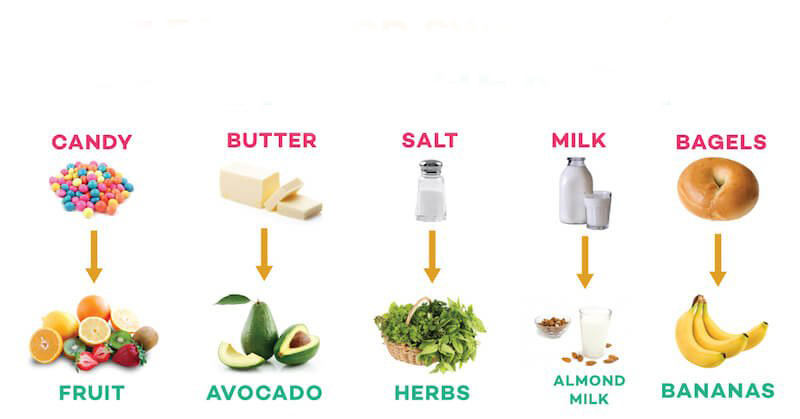Are you looking to make healthier food choices without breaking the bank? You’re not alone. Many people want to eat better but worry about the cost and how it fits into their busy lifestyles.
Fortunately, a trend is on the rise that can change the way we think about healthy eating: food swaps and community sharing programs.
These innovative platforms allow folks like you to exchange homemade, garden-grown, or foraged goodies in a friendly setting. Imagine connecting with your neighbors over fresh produce or swapping recipes that prioritize heart health—all while keeping an eye on your wallet.
This article will dive into some simple yet impactful food swap ideas and explore vibrant community sharing programs that could revolutionize your meal planning. Ready for a tastier way of life? Let’s dig in!
Key Takeaways
- Swapping out unhealthy foods for better choices can help you lose weight, control blood sugar, and reduce disease risk.
- Community sharing programs let people share food and cooking skills, which saves money and makes friends.
- Simple swaps at meals, like using beans instead of beef or whole grains over white bread, are cheaper and healthier.
- Drink water or make homemade drinks to save money and avoid too much sugar.
- To join community sharing, look for local gardens or swap events where you can grow or trade food.
The Benefits of Healthy Food Swaps

Healthy food swaps offer a range of benefits, including improved overall health, weight loss, better blood sugar and cholesterol levels, and reduced risk of chronic diseases. By making simple changes to your diet, you can experience these positive outcomes and enhance your overall well-being.
Improved overall health
Eating more veggies can make your whole body feel better. They help your stomach work well and keep you from getting sick with heart problems or diabetes. This is great news if you’re trying to stay healthy without spending much money.
You can swap out snacks like chips for carrots or celery and still munch happily.
Choosing popcorn over pretzels isn’t just about cutting back on salt; it’s also about eating less fat and sugar. These small changes add up to big wins for your health over time.
Each swap leads you closer to losing weight and feeling healthier without hurting your wallet.
Look at some easy switches you can make in the kitchen next!
Weight loss
Good health is more than just feeling okay; it means having a body that works well, too. Losing weight can be a big part of this. Making smart food swaps could help you get rid of extra pounds.
Instead of grabbing chips, try crunchy carrot sticks or apple slices. You’ll munch on fewer calories and feed your body with useful vitamins.
Healthy choices don’t have to break the bank either. Try using beans instead of red meat in your tacos or chili – they’re packed with protein but will cost you less! Plus, when you cut down on sugary drinks and sip water or herbal teas, you save money and skip unwanted sugars and fats that add weight.
Every little swap helps make your diet better without making your wallet thinner!
Better blood sugar and cholesterol levels
Losing weight is just the start. Swapping out foods high in saturated fat for options that are better for you can also help with blood sugar and cholesterol. Think about using olive oil instead of butter or choosing whole grains over white bread.
These smart swaps work hard to keep your heart healthy by lowering bad cholesterol levels.
Foods like walnuts, avocados, and fish can make a big difference in managing diabetes, too. Grab some fresh fruit or crunchy veggies instead of reaching for chips or cookies. Not only do they taste great, but they balance blood sugar so you feel good all day long!
Reduced risk of chronic diseases
By making better food choices, you can reduce the risk of chronic diseases like heart disease and Type 2 diabetes. These conditions are serious but can be prevented by eating healthier foods.
Opting for whole grains, lean meats, and plenty of vegetables can help to reduce your risk. Switching out unhealthy fats for healthier options like avocado or olive oil can also contribute to lowering the risk.
Moreover, following a diet high in dietary fiber from fruits, vegetables, and whole grains is linked to a lower risk of developing certain cancers. Making simple swaps in your diet towards more nutritious options rather than processed and high-calorie foods will benefit your health and save you money in the long run.
Simple Healthy Food Swaps

Swap out milk chocolate for dark chocolate, refined grains for whole wheat, and ground beef for cauliflower rice to enjoy healthier meals without sacrificing flavor. Discover more easy food swaps that can improve your overall health and save you money by reading on.
Breakfast swaps
Start your day with a nutritious meal without breaking the bank by trying these affordable breakfast swaps:
- Swap sugary cereals for steel-cut oats topped with fresh berries and a drizzle of honey for a fiber-packed, lower-sugar alternative.
- Replace pastries with whole-grain toast topped with avocado and a sprinkle of chili flakes for a savory, satisfying start to your day.
- Trade store-bought flavored yogurt for plain Greek yogurt mixed with a spoonful of homemade fruit compote to control sugar intake while still enjoying a sweet kick.
- Ditch expensive coffee shop lattes for homemade smoothies using ingredients like frozen fruits, leafy greens, and protein-rich Greek yogurt for a budget-friendly boost of nutrition and energy throughout your morning.
Lunchbox and lunchtime swaps
Lunchtime swaps can help you save money and eat healthier. Here are some easy lunchbox swaps to consider:
- Instead of buying pre-packaged lunches, prepare homemade meals with leftovers from dinner or bulk-cooked staples like rice and beans.
- Make your sandwiches using whole grain bread, lean protein (like turkey or chicken), and plenty of colorful veggies rather than purchasing expensive deli sandwiches.
- Skip the vending machine snacks and opt for budget-friendly options like cut-up fruits, raw veggies with hummus, or yogurt with nuts for a satisfying midday snack.
- Prepare large batches of soups or stews on weekends and portion them into individual containers for quick grab-and-go lunches throughout the week.
- Use refillable water bottles instead of buying single-serving beverages to save money while reducing waste.
Dinner swaps
Dinner swaps can make a big difference when saving money and eating healthily. You can enjoy delicious meals while sticking to your budget by making smart choices. Here are some dinner swaps that are not just economical but also good for your health:
- Replace beef with beans: Swap out some or all of the ground beef in recipes with black beans, lentils, or chickpeas. They are high in protein, fiber, and nutrients while being more budget-friendly.
- Use frozen vegetables: Instead of buying fresh vegetables that can spoil quickly, consider using frozen veggies. They are equally nutritious and often more affordable.
- Opt for whole chickens: Buying a whole chicken is often cheaper per pound than pre-cut pieces. Plus, you can use the leftover bones to make homemade broth for soups or stews.
- Try meatless meals: Incorporate more plant-based dinners into your week by swapping meat for ingredients like tofu, tempeh, or hearty vegetables like portobello mushrooms.
- Utilize cheaper cuts of meat: Choose tougher cuts like chuck roast or pork shoulder, which tend to be less expensive but can be incredibly flavorful when slow-cooked or braised.
- Make extra for leftovers: Cook in batch quantities so you have ready-made meals for the next day’s lunch or dinner, which saves time and money.
- Buy in bulk: Look for family-size packs of staple items such as rice, pasta, and grains, often offering better value for money.
- DIY convenience foods: Instead of buying pre-packaged meals or mixes, prepare them at home with basic ingredients.
Snack and pudding swaps
After making healthy swaps for dinner, it’s time to consider snack and pudding swaps. These simple changes can reduce sugar, salt, and fat in the diet. Here are some ideas:
- Replace flavored yogurt with plain yogurt mixed with fresh berries. This cuts down on added sugars commonly found in flavored yogurts.
- Try homemade banana ice cream instead of traditional ice cream. It’s a healthier and more affordable alternative.
Drink swaps
Making simple drink swaps can save money and improve health. Here are some easy and affordable drink swaps to consider:
- Choose water or unsweetened tea over sodas and sugary drinks to reduce sugar intake.
- Opt for seltzer or sparkling water instead of carbonated sugary beverages, which can positively impact health.
- Try homemade infused water with fruits or herbs as a refreshing alternative to expensive packaged drinks.
- Consider brewing your coffee at home rather than buying costly specialty coffee drinks.
Community Sharing Programs

Community sharing programs are a great way to connect with your local community and access fresh, healthy food at little to no cost. By participating in these programs, you can save money, reduce food waste, and support sustainable living.
Keep reading to learn how you can get involved in community sharing programs!
What are they?
Community-sharing programs are initiatives where people share food, skills, and resources. They help in saving money by pooling resources within the community. You can participate in collaborative growing, cooking, and distributing of food.
Sharing programs also promote strong social networks and support like-minded individuals. What’s more? Community Supported Agriculture models are emerging to deliver locally-grown produce! Ready to dive into learning about their benefits?.
Let’s first explore the benefits of healthy food swaps and how they could positively impact your health and wallet.
Benefits of participating
Participating in community sharing programs can help you save money while accessing high-quality food. By swapping surplus produce with others, you can reduce waste and get fresh items for free.
These programs also provide access to healthy foods that may otherwise be expensive, supporting a nutritious diet on a budget. Additionally, joining these programs allows you to connect with your community, share knowledge about food, and contribute to social inclusion.
Now that we’ve explored the benefits of participating in community sharing programs, let’s delve into some simple healthy food swaps.
Examples of sharing programs
Food-sharing programs are a great way to save money and access fresh, healthy food. Here are some examples of sharing programs:
- Community Gardens: These allow people to grow fruits and vegetables. Participants can share seeds, tools, and knowledge, reducing the cost of buying produce.
- Food Co-ops: Members pool resources to buy food in bulk at wholesale prices, saving money on groceries while accessing organic and locally sourced products.
- Crop Swaps: In these events, gardeners exchange excess crops with others, ensuring that no produce goes to waste and providing variety in the kitchen.
- Community Kitchens: These shared spaces allow people to cook together, reducing individual cooking costs and promoting culinary skills and recipe sharing.
- Gleaning Programs: Volunteers collect surplus produce from farms or gardens that would otherwise go unharvested and redistribute it to those in need or share it among participants.
- Seed Libraries: People can \”borrow\” seeds for planting from a community library, grow them, and then return a portion of the harvested seeds for others to use.
- Meal Sharing Networks: Individuals take turns hosting meals or potlucks where everyone brings a dish to share, fostering community bonds while saving on meal expenses.
How to get involved
Looking to save money while accessing healthy food options? Joining community sharing programs can be a fantastic way to achieve this. Here’s how you can get involved:
- Search for Local Community Gardens: Participate in community gardens to grow fresh produce and share the harvest with others.
- Food Co-ops and Buying Clubs: Join forces with others in your community to buy food in bulk at reduced prices, allowing for substantial savings.
- Swap Events: Attend or organize food swap events where participants exchange homegrown or homemade goods, fostering a sense of community and enabling cost-effective access to various foods.
- Volunteer at Community Kitchens: Contribute your time and skills at local community kitchens that prepare meals using surplus food or donations, helping provide nutritious meals for those in need while gaining access to free or low-cost food resources.
- Share Your Skills: Offer cooking, gardening, or nutrition knowledge within your community as part of an educational exchange, fostering connections while learning from others who may have different expertise.
FAQs

1. What are good food swaps to help me lose weight?
Try eating sweet potatoes instead of fries, corn tortillas instead of bread, and choose healthy snacks like fruits over chocolatey treats.
2. How can I find a balanced diet that is right for me?
Look at the MyPlate guide or talk to licensed nutritionists who understand healthy diets and can give advice based on the dietary guidelines.
3. Are community sharing programs helpful for people trying to eat healthier?
Yes, these programs offer many choices like whole grains, high-fiber veggies, and vegan options, often better than unhealthy foods like bacon or pepperoni pizza.
4. Can swapping certain foods lower my cholesterol?
Absolutely! Pick options with less total fat, avoid trans fats found in packaged foods, and choose items rich in fiber like rye bread or oat-based mueslis to aid in managing higher cholesterol levels.
5. What tasty but low-calorie swaps can I make for common meals?
Instead of regular burgers, go for veggie patties; swap out high-carb sides with grains like quinoa; enjoy spicy flavors without adding fat using herbs such as dill or cayenne pepper.
6. Can you suggest dessert alternatives that satisfy a sweet tooth but keep things healthy?
Sure! Use fruit jellies without added sugar, try dark chocolate cacao nibs full of phenolic compounds instead of candy bars, plus add nooch – a cheesy-tasting yeast – to popcorn rather than butter.

